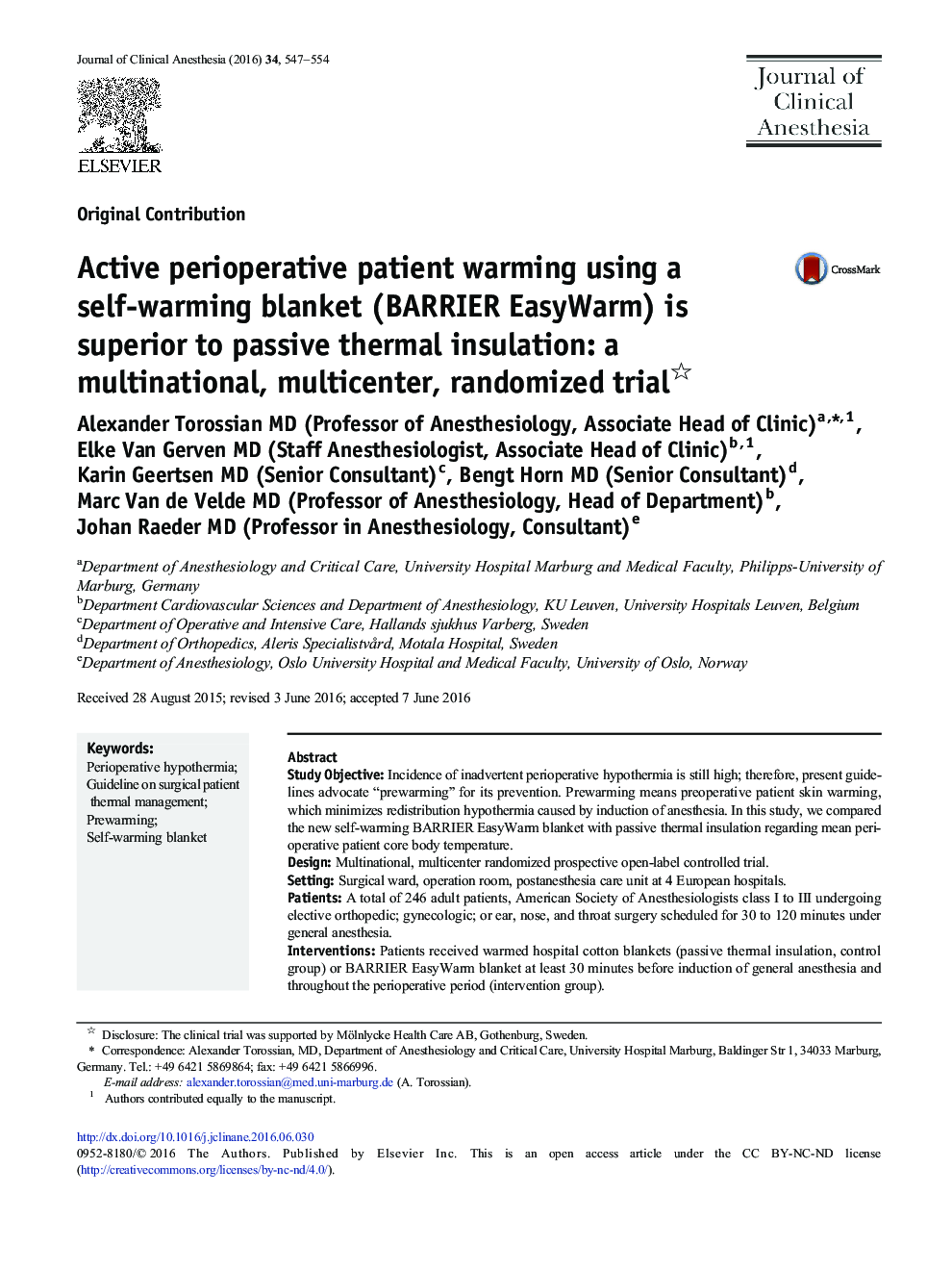| Article ID | Journal | Published Year | Pages | File Type |
|---|---|---|---|---|
| 5884572 | Journal of Clinical Anesthesia | 2016 | 8 Pages |
â¢We compared the new self-warming Barrier® EasyWarm® blanket with passive thermal insulation with regard to perioperative patient body temperature in a multinational randomized clinical trial (n=246).â¢Secondary endpoints were incidence of perioperative hypothermia (<36°C) and patients' comfort level.â¢The Barrier® EasyWarm® blanket improved perioperative patient body temperature compared with standard hospital blankets (p<0.001). Intra- and postoperative incidence of hypothermia was reduced using the new actively warming blanket (p=0.001).â¢Patients' thermal comfort was improved with the Barrier® EasyWarm® blanket without serious adverse effects.â¢The new actively warming blanket seems feasible for prewarming of surgical patients and could be easily integrated in their perioperative clinical pathway.
Study ObjectiveIncidence of inadvertent perioperative hypothermia is still high; therefore, present guidelines advocate “prewarming” for its prevention. Prewarming means preoperative patient skin warming, which minimizes redistribution hypothermia caused by induction of anesthesia. In this study, we compared the new self-warming BARRIER EasyWarm blanket with passive thermal insulation regarding mean perioperative patient core body temperature.DesignMultinational, multicenter randomized prospective open-label controlled trial.SettingSurgical ward, operation room, postanesthesia care unit at 4 European hospitals.PatientsA total of 246 adult patients, American Society of Anesthesiologists class I to III undergoing elective orthopedic; gynecologic; or ear, nose, and throat surgery scheduled for 30 to 120 minutes under general anesthesia.InterventionsPatients received warmed hospital cotton blankets (passive thermal insulation, control group) or BARRIER EasyWarm blanket at least 30 minutes before induction of general anesthesia and throughout the perioperative period (intervention group).MeasurementsThe primary efficacy outcome was the perioperative mean core body temperature measured by a tympanic infrared thermometer. Secondary outcomes were hypothermia incidence, change in core body temperature, length of stay in postanesthesia care unit, thermal comfort, patient satisfaction, ease of use, and adverse events related to the BARRIER EasyWarm blanket.Main ResultsThe BARRIER EasyWarm blanket significantly improved perioperative core body temperature compared with standard hospital blankets (36.5°C, SD 0.4°C, vs 36.3, SD 0.3°C; P < .001). Intraoperatively, in the intervention group, hypothermia incidence was 38% compared with 60% in the control group (P = .001). Postoperatively, the figures were 24% vs 49%, respectively (P = .001). Patients in the intervention group had significantly higher thermal comfort scores, preoperatively and postoperatively. No serious adverse effects were observed in either group.ConclusionsPerioperative use of the new self-warming blanket improves mean perioperative core body temperature, reduces the incidence of inadvertent perioperative hypothermia, and improves patients' thermal comfort during elective adult surgery.
